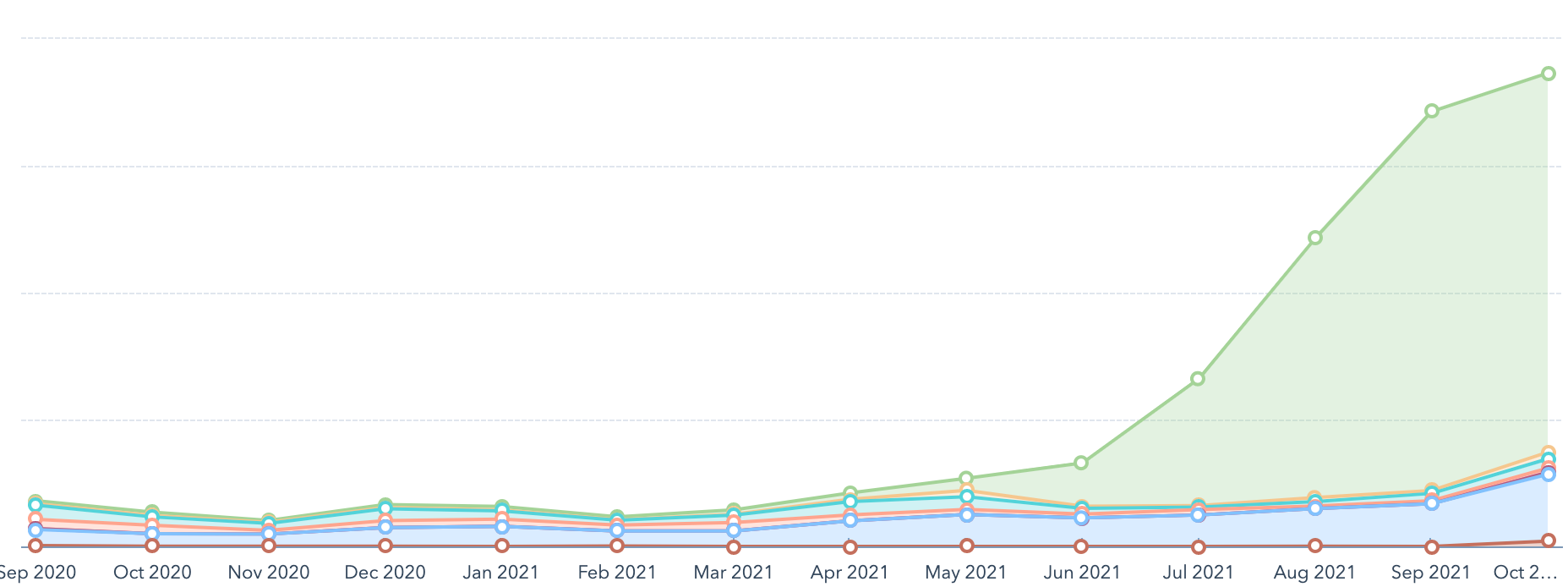It’s been just over a year since Hayes and I officially incorporated Gradient Works. Throughout this process, we’ve tried to be transparent about the process and our progress. So let’s check in and see where we are. Now that we're a year in, what have we learned about marketing?
Progress to this point
We recently launched Gradient Works - the first iteration of our product - and announced our seed funding. We’re selling a real product to real companies now - no more “early access” or beta testing. Happily, we've been exceeding our sales goals and look to be on target for Q4. We all know that startups are capricious beasts and our fortunes will change at some point, but right now, things are chugging along nicely.
Our goal at this stage is learning as much as we can - about our customer, our market, our positioning, our competitors. We want to prove that these early customers aren’t flukes, that we’re building a reliable revenue engine that can produce significant growth quarter after quarter. We’re lucky that our lead investor, Integr8d Capital, believes in the power of learning as much as we do, and is supporting these learning efforts in our early days.
So, what have we learned so far about marketing this thing? Before publishing this post, we debated internally just how honest to be here - how transparent is too transparent? And we decided on full transparency. Why not, right? If some of the things we’ve learned can help someone else, great. I’ve worked in marketing and communications for 20 years, and I’m still constantly learning. Seems only right to be upfront about that. So buckle up. It's not all pretty.
What we’ve learned about marketing, one year in
Since we’re selling a real product now, that means I’ve moved on from pre-product marketing to just regular old marketing. We’re still very early stage though, so there’s a lot of building and experimentation. We try something, see how it lands, adjust and try again.
You may be subscribed to our Up and to the Right newsletter. (If you’re not, you should be.) We’ve learned quite a bit about what it takes to produce high-quality newsletter content on a regular cadence. We wrote about the newsletter when it was brand new and more recently about what’s changed in the past year. Tl;dr - it takes a lot of time to produce a weekly email with all new original content, and while we love the newsletter and our readers, my time is limited and needs to be focused more on revenue-generating marketing at this stage. So we moved to a monthly newsletter cadence that fits in with our workflow a lot better.
Experimentation is hard when your audience is small. You want to run big A/B tests that definitively show that one option is statistically significantly better than the other. But you can’t if you only have a few dozen, or even a few hundred, participants in a test. So it can take longer to determine if something is working. And sometimes we don’t know for sure, but we need to make a choice based on the data we do have anyway. That’s okay at this stage.
It turns out that we’re really good at creating content people want to read. We’ve demonstrated that we understand SEO and have built a strong foundation. So even though our site is young and small, we can drive relatively outsized search traffic. Here’s a chart of gradient.works traffic over the past year. There’s both an increase in overall traffic and an accelerating share of search traffic (organic search is shown in green). We’ve taken SEO very seriously from the very beginning, and those efforts are paying off a year later. The lesson here: it's never too early to think about SEO.

Okay good, so we can get people to our site. People tell us they like what we’re talking about. That’s great! It really is! But it’s not enough. We need to figure out how to turn eyeballs into dollars. (Not literally, come on.)
So we still need to do quite a bit of work to figure out how to convert more inbound search traffic to prospects. That means figuring out if this is the right audience - are they potential buyers? And it means learning what else we can provide this audience when they come to our site. Likely, they’re not ready to go from a blog post about Salesforce Flow straight to a demo request, so what else can we do to engage them, to get them interested in learning more? This will be one of my major goals over the next 6 months. I've been experimenting with different CTAs for those funnels, so we'll see what we learn.
Personally, I still have a lot to learn about the operations side of marketing. I’m not particularly experienced in how we connect HubSpot to LinkedIn to make sure we’re tracking LinkedIn ads correctly. And why is it that some types of HubSpot forms track clicks but others don’t? I’m sure our Google Analytics setup still needs work. And every time I think I’ve got our Salesforce integration working correctly, I find some other SFDC capability I’ve never used before.
We need MOPs skills on our team, for sure. I can muddle through for now, but it’s not a strength. And we’ll hire someone to handle marketing ops soonish. But we’re still very small, and there are other roles across the company we need to hire first. At this stage, it’s always about handoffs. For example, if we hire a marketing ops role, then we might not be able to hire another engineer right now. And at this stage, product development matters more than the perfect marketing operations setup.
We should focus on what’s working right now. And if our content is working so well, we should double down on that, right? Yes, of course. But since I can only write so many words per day, we need to find someone else to do that. We’ve been working with a number of external contributors - guest bloggers, ghost writers, freelancers, even apps - to fill that content gap. And wow is it hard to get reliable, consistent, and high-quality content flow from outsourced content. So should we hire a full-time content creator? Maybe, even probably. But again, tradeoffs.
One of the harder lessons I've learned is that I still suck at PR. That probably sounds ridiculous if you met me during my Cision days when I ran comms (or maybe it doesn’t 🤪). I researched a press list for our launch, did targeted, personalized outreach, wrote a decent press release with customer and investor quotes. But still, very little press coverage. That’s okay - we’re new and honestly, the story’s not that interesting - “startup you’ve never heard of from founders you’ve probably also not heard of has a new product for a market you don’t care a lot about and has raised money but so has literally everyone else” isn’t that compelling. And that’s okay. For now. I know how valuable earned media can be, and it’s something we will work on. But it’s not top priority at this stage.
Case studies take so much time and attention. I truly believe a robust case study program is possible. But I think it takes a special set of skills to manage. You have to follow up over and over, without being annoying. You have to create a compelling narrative, with real data, and that can be hard to get a client to agree to, even if it's written into your contract. Good, repeatable case studies take time and so much effort. We're not there yet, though we are working on some good ones. Coming soon, I hope.
And then there are the squishier lessons. The coolest and hardest part of startup marketing is that even the most experienced marketer is starting from scratch. So it's awesome because you've got a blank slate and there's only one way to go (up). But it's frustrating because everything you've learned and everything you've done before only goes so far in this new context. It can be difficult to ignore your assumptions about what should work, and to instead focus on experimentation, feedback, and learning. So here are the squishy lessons I've learned:
- Be ruthless about prioritization
- Lean into what works
- Keep iterating on what isn't working - yet
- Try things, and then try more things
- Don't assume that just because you've tried it before, it'll work the same now
- Everyone has ideas, and it can be good to listen to them
- Do something every single day
So there we go - my totally transparent distillation of what we've learned about marketing a year+ into Gradient Works. I'd love to talk more about this, so come find me on LinkedIn if you want to discuss. Thank you for making it all the way to the end of the post, and for following along on this journey.
And if you work in RevOps or other sales role, I humbly ask that you take a look at Gradient Works. Maybe take a demo - see if our rules of engagement and assignment automation would work for your company. It starts with lead routing but does so much more.




